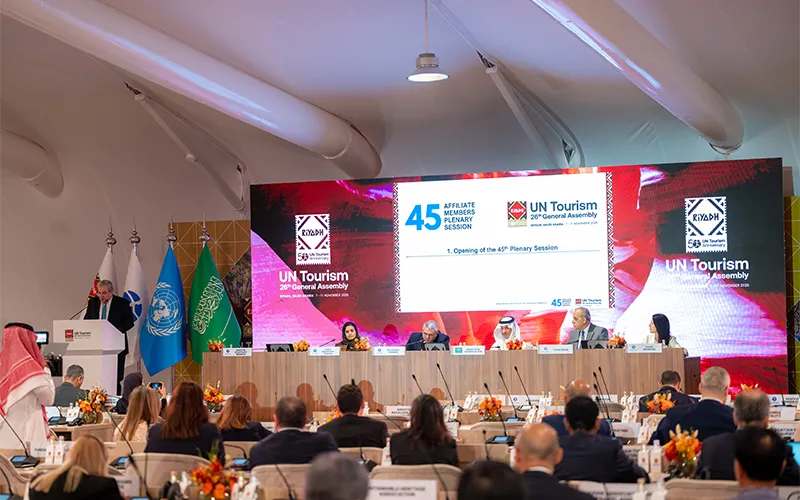Alumni Spotlight: Bridging Science, Policy and Strategy for Climate Action – Columbia University

Report on Tiffany Wu’s Contributions to Sustainable Development Goals
Professional Profile and Alignment with Global Goals
Tiffany Wu, a 2023 graduate of Columbia University’s MPA in Environmental Science and Policy, serves as a Senior Program Associate at Winrock International. Her work focuses on implementing solutions that address complex social and environmental challenges, directly contributing to the United Nations Sustainable Development Goals (SDGs).
- SDG 13 (Climate Action): Ms. Wu’s primary role involves climate and sustainability projects, including work on carbon markets and corporate greenhouse gas (GHG) accounting.
- SDG 7 (Affordable and Clean Energy): Her portfolio includes projects dedicated to advancing clean energy solutions.
- SDG 12 (Responsible Consumption and Production): She promotes corporate accountability by working with standards like the GHG Protocol and the Science Based Targets initiative, encouraging sustainable business practices.
Advancing Climate Action (SDG 13) Through Multi-Sectoral Engagement
At Winrock International, Ms. Wu’s responsibilities span multiple facets of climate mitigation and adaptation, reflecting a comprehensive approach to achieving SDG 13.
- Corporate Climate Strategy: She assists organizations in navigating the landscape of climate standards to take meaningful action on emissions reduction. This includes developing the Corporate Climate Contribution Index, an initiative designed to provide transparent evaluation of corporate efforts, fostering accountability and supporting SDG 17 (Partnerships for the Goals).
- Carbon Markets and GHG Accounting: Her work in the voluntary carbon market and corporate GHG accounting provides the technical foundation for companies to measure and manage their climate impact, a critical step for fulfilling targets under SDG 13.
- Non-Profit Operations: By engaging in proposal writing and grant management, Ms. Wu gains a holistic understanding of the mechanisms that fund and sustain climate-focused initiatives, highlighting the operational realities of non-profits working towards the SDGs.
Foundational Experience in Biodiversity and Policy (SDG 15)
Ms. Wu’s career path was significantly influenced by her formative fieldwork studying California spotted owls. This experience provided direct insight into the intersection of science, policy, and conservation.
- Protecting Terrestrial Ecosystems: The research directly contributed to the protection of forest habitats under the state’s Endangered Species Act. Confirming nesting pairs led to the preservation of land, demonstrating a tangible outcome for SDG 15 (Life on Land).
- Science-Policy Interface: The work illustrated how scientific data on habitat requirements for species viability can inform and strengthen environmental policy. This feedback loop is essential for creating effective conservation strategies aligned with SDG 15’s targets.
Academic Contributions to Sustainable Cities and Climate Policy (SDG 11 & SDG 13)
During her MPA program at Columbia University, Ms. Wu engaged in projects that provided actionable strategies for implementing global and national sustainability agendas.
- Capstone Project on Urban Climate Action: Ms. Wu collaborated with C40 Cities to analyze the implementation of the U.S. Inflation Reduction Act. This project focused on making complex federal legislation actionable for urban centers, directly supporting SDG 11 (Sustainable Cities and Communities) and its goal of enhancing sustainable urbanization and climate resilience.
- Corporate Sustainability Reporting: Coursework on corporate sustainability reporting and strategy provided hands-on experience with frameworks like the Global Reporting Initiative, equipping her with the skills to drive corporate responsibility in line with SDG 12 (Responsible Consumption and Production).
Which SDGs are addressed or connected to the issues highlighted in the article?
- SDG 7: Affordable and Clean Energy: The article mentions Tiffany Wu’s work on “clean energy” projects, which is a core component of this goal.
- SDG 11: Sustainable Cities and Communities: The capstone project working with “C40 Cities on how U.S. cities could implement the Inflation Reduction Act” directly addresses the sustainability and climate resilience of urban areas.
- SDG 12: Responsible Consumption and Production: The focus on “corporate greenhouse gas accounting,” “Corporate Sustainability Reporting,” and initiatives like the “Science Based Targets initiative” and “Global Reporting Initiative” relates to encouraging companies to adopt sustainable practices and report on their impact.
- SDG 13: Climate Action: This is a central theme. Wu’s work involves “climate and sustainability projects,” “carbon markets,” “corporate greenhouse gas accounting,” and implementing the “Inflation Reduction Act,” all of which are direct actions to combat climate change.
- SDG 15: Life on Land: Wu’s formative experience involved fieldwork with California spotted owls, a species “protected under the state’s Endangered Species Act.” Her research directly led to policy decisions to “conserve habitats” and protect forests from being sold, which is fundamental to preserving terrestrial ecosystems and biodiversity.
- SDG 17: Partnerships for the Goals: The article highlights the importance of collaboration across different sectors. Wu has worked in “corporate, nonprofit, public-sector roles,” and her project with C40 Cities is a clear example of a multi-stakeholder partnership aimed at achieving sustainability objectives.
What specific targets under those SDGs can be identified based on the article’s content?
-
SDG 7: Affordable and Clean Energy
- Target 7.2: By 2030, increase substantially the share of renewable energy in the global energy mix. Wu’s work on “clean energy” projects directly contributes to this target.
-
SDG 11: Sustainable Cities and Communities
- Target 11.b: By 2020, substantially increase the number of cities and human settlements adopting and implementing integrated policies and plans towards inclusion, resource efficiency, mitigation and adaptation to climate change. The project with C40 Cities to make the “Inflation Reduction Act…actionable for cities” is a direct implementation of this target.
-
SDG 12: Responsible Consumption and Production
- Target 12.6: Encourage companies, especially large and transnational companies, to adopt sustainable practices and to integrate sustainability information into their reporting cycle. Wu’s work with “Corporate Sustainability Reporting,” the “Global Reporting Initiative,” and the “Science Based Targets initiative” directly supports this target by promoting corporate accountability and transparency.
-
SDG 13: Climate Action
- Target 13.2: Integrate climate change measures into national policies, strategies and planning. The work on implementing the “Inflation Reduction Act” at the city level is a clear example of integrating a national climate policy into local planning.
- Target 13.3: Improve education, awareness-raising and human and institutional capacity on climate change mitigation. Wu’s role in bridging the “gap between science and policy” and helping organizations “take meaningful climate action” contributes to building institutional capacity.
-
SDG 15: Life on Land
- Target 15.5: Take urgent and significant action to reduce the degradation of natural habitats, halt the loss of biodiversity and, by 2020, protect and prevent the extinction of threatened species. The research on California spotted owls, which are “protected under the state’s Endangered Species Act,” directly influenced “policy decisions being made to conserve habitats” and prevent the “survival of an endangered species” from being threatened.
- Target 15.2: By 2020, promote the implementation of sustainable management of all types of forests, halt deforestation… The direct outcome of the owl research was that a confirmed nesting pair meant that “area of the forest would not be sold off by the U.S. Forest Service and would remain protected,” contributing to halting the loss of forest habitats.
-
SDG 17: Partnerships for the Goals
- Target 17.17: Encourage and promote effective public, public-private and civil society partnerships. Wu’s career path across “corporate, nonprofit and public-sector roles” and her project work with organizations like Winrock International and C40 Cities exemplify the multi-stakeholder partnerships needed to advance sustainability.
Are there any indicators mentioned or implied in the article that can be used to measure progress towards the identified targets?
-
SDG 12: Responsible Consumption and Production
- Implied Indicator for Target 12.6: The number of companies adopting reporting standards. The article’s mention of the “Global Reporting Initiative” and “Corporate Sustainability Reporting” implies that a key metric is the adoption of these frameworks by corporations, which aligns with Indicator 12.6.1 (Number of companies publishing sustainability reports).
-
SDG 13: Climate Action
- Implied Indicator for Target 13.2: Greenhouse gas emissions levels. The work on “corporate greenhouse gas accounting” and the “Corporate Climate Contribution Index” initiative, which aims to understand contributions to “global greenhouse gas emissions-cutting efforts,” directly points to measuring GHG emissions as a key indicator of progress. This relates to Indicator 13.2.2 (Total greenhouse gas emissions per year).
-
SDG 15: Life on Land
- Implied Indicator for Target 15.5: Population counts of endangered species. The fieldwork involved conducting “occupancy and reproductive surveys” and confirming “a nesting pair” of spotted owls. This count of a threatened species serves as a direct indicator of the health of the species and its habitat, relating to Indicator 15.5.1 (Red List Index).
- Implied Indicator for Target 15.2: Area of protected forest. The statement that a confirmed nesting pair ensured an “area of the forest would not be sold off…and would remain protected” implies that the area of land under protection is a key metric for conservation success. This relates to Indicator 15.1.2 (Proportion of important sites for terrestrial…biodiversity that are covered by protected areas).
Table of SDGs, Targets, and Indicators
| SDGs | Targets | Indicators (Mentioned or Implied in Article) |
|---|---|---|
| SDG 12: Responsible Consumption and Production | 12.6: Encourage companies to adopt sustainable practices and integrate sustainability information into their reporting cycle. | Number of companies using frameworks like the “Global Reporting Initiative” for “Corporate Sustainability Reporting.” |
| SDG 13: Climate Action | 13.2: Integrate climate change measures into national policies, strategies and planning. | Measurement of “corporate greenhouse gas” emissions and contributions to “global greenhouse gas emissions-cutting efforts” via an index. |
| SDG 15: Life on Land | 15.5: Take urgent action to halt the loss of biodiversity and prevent the extinction of threatened species. | Results of “occupancy and reproductive surveys” for threatened species like the California spotted owl (“confirmed a nesting pair”). |
| SDG 15: Life on Land | 15.2: Promote the implementation of sustainable management of all types of forests, halt deforestation. | Area of forest that “would not be sold off… and would remain protected” as a result of conservation research. |
Source: news.climate.columbia.edu

What is Your Reaction?
 Like
0
Like
0
 Dislike
0
Dislike
0
 Love
0
Love
0
 Funny
0
Funny
0
 Angry
0
Angry
0
 Sad
0
Sad
0
 Wow
0
Wow
0



































































![Lancaster homeowner’s energy-efficient renovation sparks clash over historic preservation [Lancaster Watchdog] – LancasterOnline](https://bloximages.newyork1.vip.townnews.com/lancasteronline.com/content/tncms/assets/v3/editorial/9/ed/9ed03d32-c902-44d2-a461-78ad888eec38/69050b156baeb.image.png?resize=150,75#)









